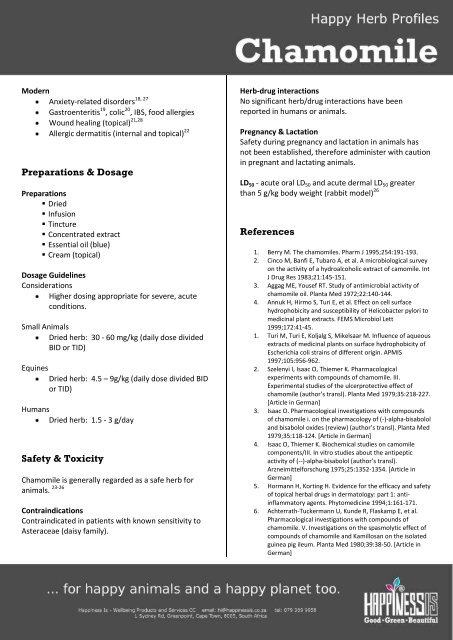Chamomile flower (Matricaria recutita) - Happiness Is
Chamomile flower (Matricaria recutita) - Happiness Is
Chamomile flower (Matricaria recutita) - Happiness Is
Create successful ePaper yourself
Turn your PDF publications into a flip-book with our unique Google optimized e-Paper software.
Modern<br />
18, 27<br />
Anxiety-related disorders<br />
Gastroenteritis 19 , colic 20 , IBS, food allergies<br />
Wound healing (topical) 21,28<br />
Allergic dermatitis (internal and topical) 22<br />
Preparations & Dosage<br />
Preparations<br />
Dried<br />
Infusion<br />
Tincture<br />
Concentrated extract<br />
Essential oil (blue)<br />
Cream (topical)<br />
Dosage Guidelines<br />
Considerations<br />
Higher dosing appropriate for severe, acute<br />
conditions.<br />
Small Animals<br />
Dried herb: 30 - 60 mg/kg (daily dose divided<br />
BID or TID)<br />
Equines<br />
Dried herb: 4.5 – 9g/kg (daily dose divided BID<br />
or TID)<br />
Humans<br />
Dried herb: 1.5 - 3 g/day<br />
Safety & Toxicity<br />
<strong>Chamomile</strong> is generally regarded as a safe herb for<br />
animals. 23-26<br />
Contraindications<br />
Contraindicated in patients with known sensitivity to<br />
Asteraceae (daisy family).<br />
Herb-drug interactions<br />
No significant herb/drug interactions have been<br />
reported in humans or animals.<br />
Pregnancy & Lactation<br />
Safety during pregnancy and lactation in animals has<br />
not been established, therefore administer with caution<br />
in pregnant and lactating animals.<br />
LD50 - acute oral LD50 and acute dermal LD50 greater<br />
than 5 g/kg body weight (rabbit model) 26<br />
References<br />
1. Berry M. The chamomiles. Pharm J 1995;254:191-193.<br />
2. Cinco M, Banfi E, Tubaro A, et al. A microbiological survey<br />
on the activity of a hydroalcoholic extract of camomile. Int<br />
J Drug Res 1983;21:145-151.<br />
3. Aggag ME, Yousef RT. Study of antimicrobial activity of<br />
chamomile oil. Planta Med 1972;22:140-144.<br />
4. Annuk H, Hirmo S, Turi E, et al. Effect on cell surface<br />
hydrophobicity and susceptibility of Helicobacter pylori to<br />
medicinal plant extracts. FEMS Microbiol Lett<br />
1999;172:41-45.<br />
1. Turi M, Turi E, Koljalg S, Mikelsaar M. Influence of aqueous<br />
extracts of medicinal plants on surface hydrophobicity of<br />
Escherichia coli strains of different origin. APMIS<br />
1997;105:956-962.<br />
2. Szelenyi I, <strong>Is</strong>aac O, Thiemer K. Pharmacological<br />
experiments with compounds of chamomile. III.<br />
Experimental studies of the ulcerprotective effect of<br />
chamomile (author’s transl). Planta Med 1979;35:218-227.<br />
[Article in German]<br />
3. <strong>Is</strong>aac O. Pharmacological investigations with compounds<br />
of chamomile i. on the pharmacology of (-)-alpha-bisabolol<br />
and bisabolol oxides (review) (author’s transl). Planta Med<br />
1979;35:118-124. [Article in German]<br />
4. <strong>Is</strong>aac O, Thiemer K. Biochemical studies on camomile<br />
components/III. In vitro studies about the antipeptic<br />
activity of (--)-alpha-bisabolol (author’s transl).<br />
Arzneimittelforschung 1975;25:1352-1354. [Article in<br />
German]<br />
5. Hormann H, Korting H. Evidence for the efficacy and safety<br />
of topical herbal drugs in dermatology: part 1: antiinflammatory<br />
agents. Phytomedicine 1994;1:161-171.<br />
6. Achterrath-Tuckermann U, Kunde R, Flaskamp E, et al.<br />
Pharmacological investigations with compounds of<br />
chamomile. V. Investigations on the spasmolytic effect of<br />
compounds of chamomile and Kamillosan on the isolated<br />
guinea pig ileum. Planta Med 1980;39:38-50. [Article in<br />
German]


